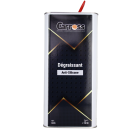Carross bodywork degreaser

Carross professional bodywork degreaser
︾
Carross bodywork Degreaser:
Carross Degreaser is a product designed to remove greasy, oily and sticky contaminants from the surface of a car body. It plays a crucial role in the surface preparation process prior to the application of paint or other coatings. Here are some of the main functions of Degreaser:
Grease and oil removal:
The bodywork degreaser is specifically formulated to dissolve and remove residues of grease, oil and other fatty substances from the bodywork surface. These contaminants may come from the environment, vehicle maintenance or previous handling.
Preparing the surface for Paint :
Before applying a new coat of Paint, it is essential that the bodywork surface is clean and free of any contaminants. Degreaser ensures a clean base for optimum paint adhesion and a quality finish.
Removal of wax and polish residues:
Maintenance products such as waxes and polishes can leave greasy residues on the bodywork. Degreaser removes these residues, ensuring adequate preparation before any subsequent treatment.
Cleaning metal surfaces:
On metal surfaces, Degreaser removes traces of grease and oil that can compromise the adhesion of protective coatings or anti-corrosion treatments.
Improves the adhesion of adhesives:
For repairs requiring the use of adhesives, Degreaser Carrosserie ensures a clean surface, promoting optimum adhesion and a long-lasting bond.
Preliminary step for repairs:
Prior to any bodywork repair, Body Degreaser is often used to remove contaminants that could interfere with the repair process, such as welding, fitting putties or fitting new parts.
It is important to note that the choice of bodywork degreaser should be made according to the type of paint or coating that will be applied afterwards. Some Degreasers may contain more aggressive solvents, while others are formulated to be compatible with specific paints.
Carross anti-silicone bodywork Degreaser :
The Carross Anti-Silicone Body Degreaser is specially formulated to remove silicone-related contamination from the surface of a car body. Silicones can come from maintenance products, waxes, polishes or even the environment, and they can create problems when preparing the surface for Paint. Here are some of the specific benefits of anti-silicone body degreaser:
Effective silicone removal:
The main benefit of an anti-silicone body degreaser is its effectiveness in removing silicone residues. These contaminants can be particularly problematic, as they can lead to paint adhesion problems.
Optimum preparation for Paint :
By removing silicones, the Anti-Silicone Body Degreaser creates a clean, contaminant-free surface. This promotes optimum paint adhesion, which is essential for a high quality finish.
Compatibility with sensitive paints:
Some anti-silicone degreasers are formulated to be compatible with sensitive paints, minimising the risk of altering the paint's composition.
Essential step for precise bodywork:
When carrying out bodywork that requires meticulous preparation, such as paint touch-ups or Partial repairs, the use of an anti-silicone bodywork degreaser is an essential step in guaranteeing professional results.
Reduce the risk of reprojection:
Silicones can contaminate the surrounding air and cause paint reprojection problems. By eliminating these contaminants, Degreaser helps to maintain a clean working environment.
It is important to note that the use of an anti-silicone body degreaser must comply with the manufacturer's recommendations. It is generally recommended to follow the appropriate cleaning, rinsing and drying steps after applying the Degreaser to ensure that the surface is ready for painting.
Questions about using Degreaser anti-silicone for your bodywork :
Users may ask a variety of questions about the application of Degreaser Silicone when preparing a bodywork surface. Here are some of the questions most frequently asked by users:
1. How often should I use an anti-silicone body degreaser on my bodywork?
The frequency of use depends on various factors such as the environment, vehicle use and the type of contaminants present. In general, we recommend that you use it before applying any paint.
2. How can I identify the presence of silicones on the surface of my bodywork?
Silicones can sometimes be difficult to detect with the naked eye. Imperfections in the paint, water repellence or the formation of "fish eyes" may indicate the presence of silicones. A preliminary test can be carried out to check the surface.
3. Are there any special precautions to be taken when applying an anti-silicone Degreaser?
Yes, it is important to follow the manufacturer's recommendations. This may include using personal protective equipment, applying in a well-ventilated environment and respecting the specified drying times.
4. Is the Degreaser suitable for all types of paint?
Some silicone degreasers can be formulated to be compatible with different types of paint, but it is crucial to check the specific compatibility with the type of paint being used.
5. Can I use an anti-silicone degreaser on all bodywork surfaces, including plastic and glass?
Compatibility with different surfaces may vary depending on the product. We recommend consulting the manufacturer's instructions to confirm compatibility with plastic, glass and other materials.
6. Do I need to rinse the surface after applying the silicone degreaser?
Yes, in many cases it is recommended to rinse the surface with a suitable cleaner after applying the Degreaser to remove any residue. This ensures a clean surface for paint application.
7. Can I use an anti-silicone degreaser as a regular cleaner for my bodywork?
Although a silicone degreaser is effective in removing silicones, it is generally recommended to use it specifically when preparing for paintwork. For regular cleaning, it's best to use products designed for everyday use.
It's vital to refer to the specific instructions of the manufacturer of the silicone degreaser you're using, as recommendations can vary between formulations and brands.
